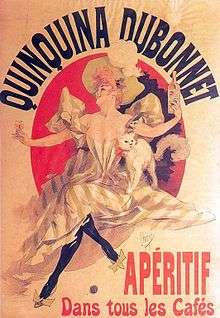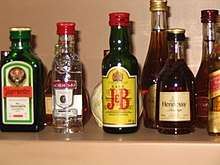Dubonnet




Dubonnet is a sweet, aromatised wine-based aperitif with 15% alcohol by volume.[1] It is a blend of fortified wine, herbs, and spices (including a small amount of quinine),[2] with fermentation being stopped by the addition of alcohol. The brand is currently produced in France by Pernod Ricard, and in the USA by Heaven Hill Distilleries of Bardstown, Kentucky.[1] The company says it is the "number-one selling aperitif brand in the United States".[1] The beverage is famous in the UK for having been the favourite drink of Elizabeth Bowes-Lyon, the Queen Mother.[3]
History
Dubonnet was first sold in 1846 by Joseph Dubonnet, in response to a competition run by the French Government to find a way of persuading French Foreign Legionnaires in North Africa to drink quinine.[2] Quinine combats malaria but is very bitter.
The brand ownership was taken over by Pernod Ricard in 1976. It was re-popularised in late-1970s by an advertising campaign starring Pia Zadora. It is available in Rouge, Blanc and Gold (vanilla and orange) varieties. Dubonnet is also widely known by the advertisement slogan of the French graphic designer Cassandre "Dubo, Dubon, Dubonnet" (a play on words roughly meaning "It's nice; it's good; it's Dubonnet"), which still can be found on the walls of houses in France. The brand later became owned by Heaven Hill.[1]
Dubonnet is commonly mixed with lemonade or bitter lemon, and forms part of many cocktails.
Reputedly Dubonnet is a favourite beverage of:
- Queen Elizabeth The Queen Mother, who liked gin and Dubonnet: 30% gin, 70% Dubonnet with a slice of lemon under the ice. She once noted before a trip, "I think that I will take two small bottles of Dubonnet and gin with me this morning, in case it is needed."[4][5]
- Queen Elizabeth II, who likes two-parts Dubonnet and one-part gin with two cubes of ice and a lemon slice before lunch every day.[6]
- Nelson Rockefeller, whose taste for alcohol was moderate, would have an occasional glass of Dubonnet on the rocks.[7]
Cocktails
The following include Dubonnet as one of their ingredients:
- Alfonso, The
- Apple Dubonnet
- Arnaud's Special (New Orleans)
- Bartender
- Bentley
- Blackthorn Cocktail
- Dubonnet Cassis
- Dubonnet Cocktail
- Dubonnet Daniella
- Dubonnet Delight
- Dubonnet Fizz
- Dubonnet Helado
- Dubonnet Highball
- Dubonnet Kiss
- Dubonnet Manhattan
- Dubonnet Negroni
- Dubonnet Royal
- Dubonnet TT
- Jack London Martini
- Opera Cocktail
- Red Moonlight
- Rum Dubonnet
- San Diego Cocktail
- Savoy Hotel Special
- Trois Rivieres
- Mummy Love
- Marble Hill
- Napoleon
- Karl-Gerhard
- Bossunova Belt
- Magic Juice
- The Queen Mother
- The Mexican
See also
- Gin and tonic, another drink invented to encourage European colonial soldiers in tropical climates to take quinine.
External links
References
- 1 2 3 4 Official website
- 1 2 Geoghegan, Tom (July 20, 2009). "Who still drinks Dubonnet?". BBC News. Retrieved November 25, 2011.
- ↑ "Make your own Queen Mother cocktail".
- ↑ "Queen Mother 'pack gin' note sold". BBC News. July 5, 2008. Retrieved May 1, 2015.
- ↑ "Rare insight into Queen Mum's life as Backstairs Billy mementos sold". Hello!. July 3, 2008. Archived from the original on September 22, 2012. Retrieved May 1, 2015.
- ↑ Alderson, Andrew (July 5, 2009). "Exclusive: behind the scenes with the Queen". The Daily Telegraph. London. Retrieved November 25, 2011.
- ↑ Clines, Francis (August 20, 1974). "Always Wanted Presidency: Rocky Settles for Second". The Register-Guard. Eugene, Oregon. The New York Times. p. 12c.


